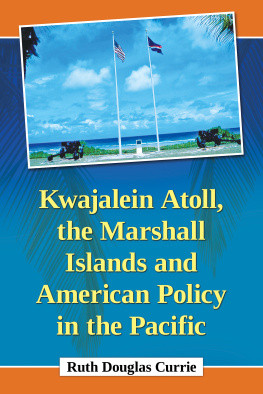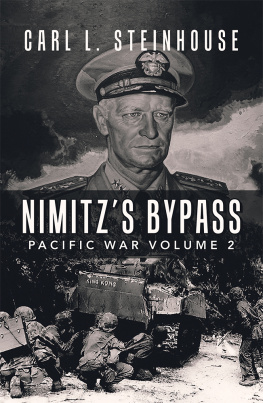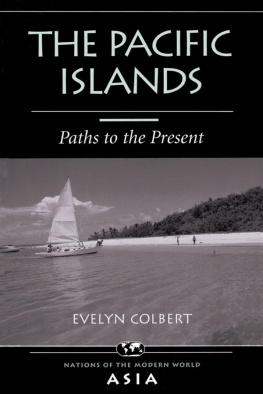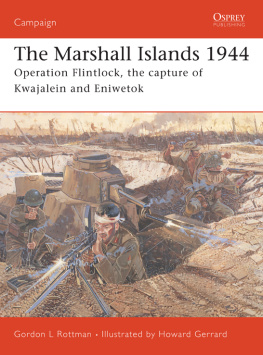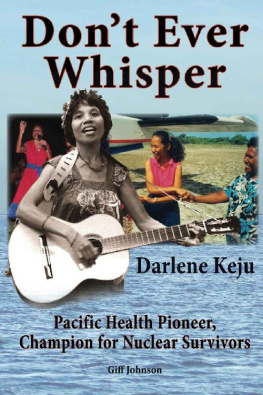
Kwajalein Atoll, the Marshall Islands and American Policy in the Pacific
Ruth Douglas Currie

McFarland & Company, Inc., Publishers
Jefferson, North Carolina
LIBRARY OF CONGRESS CATALOGUING DATA ARE AVAILABLE
BRITISH LIBRARY CATALOGUING DATA ARE AVAILABLE
e-ISBN: 978-1-4766-2632-1
2016 Ruth Douglas Currie. All rights reserved
No part of this book may be reproduced or transmitted in any form or by any means, electronic or mechanical, including photocopying or recording, or by any information storage and retrieval system, without permission in writing from the publisher.
Front cover photograph of Kwajalein Island, Command Flags (U.S. Army Photo)
McFarland & Company, Inc., Publishers
Box 611, Jefferson, North Carolina 28640
www.mcfarlandpub.com
For Ken
Acknowledgments
In a project encompassing so many years, there are scores of people to thank for their assistance. First is Colonel Michael Volpe, who served as Administrative Assistant to Lieutenant General John F. Wall, Commander, U.S. Army Strategic Defense Command (USASDC). With a keen appreciation for history, Colonel Volpe required that the Command Historian be part of the Generals staff. In that capacity, I attended briefings and had access to many classified reports concerning the Research & Development phase of the Armys efforts in missile defense and advanced research projects. Colonel Volpe asked me to write a brief history of the Armys role in President Reagans Strategic Defense Initiative (SDI), which I did, aided by my Assistant, Claus Martel, and Administrative Assistant, Ruthie Poe, using the documents available to us in the Historical Office.
Colonel Volpes next assignment was to write a broader history of the Armys ballistic-missile defense operation and base in Kwajalein Atoll, Marshall Islands. He allowed Claus Martel to travel with me to Kwajalein for a week-long research trip. I thank Claus for his support and assistance in many capacities on that trip. He took many of the photographs that appear in this publication. Later, Colonel Volpe authorized a research trip for me to Hawaii and arranged an interview with Ambassador Fred Zeder, who graciously provided a valuable window into the background of the Trust Territory Government and the contribution of High Commissioner Janet McCoy. While in Hawaii, I did extensive work with the TTPI Archives and Pacific Collection Archives at the University of Hawaii Library. Thanks to Karen Peacock who guided me to many archival sources in the Pacific Collection, especially to the extraordinary collection of German documents from the period of German control of the Marshalls. Karen also arranged an interesting conversation with Stewart Firth, who had translated the German documents and whose own research and writing on the Pacific have been valuable. A weeks trip to Newport, RI, and the Naval War College Library provided more depth for my research.
Back in DC, the Armys Center for Military History files were open to me and provided eyewitness evidence for conditions on the ground after the Battle of Kwajalein. Through more years, my thanks for the Armys continued support from friends such as USASDC Public Affairs Coordinator Ed Vaughn and for access to records in the Historical Office after my tenure, including permission to use the research from my trips to Kwajalein and Hawaii. The Armys primary sources of the commands Annual History Reports and Reports of the Trust Territory Government, Congress of Micronesia, and Future Political Status Commission were invaluable in seeing the Marshallese perspective in negotiations.
My thanks to Sharon Watkins Lang in the USASMDC/ARSTRAT Historical Office for help with multiple inquiries and information. Especially helpful was the contact with John Fairlamb, Ph.D., who served as the Armys Representative in the Office of Compact Negotiations in the U.S. Department of State and participated in Compact negotiations for four years. After returning to USASDC Headquarters, he led critical discussions and advised the Army on implementation of the Kwajalein Land Use Agreement and the amended Military Use and Operating Rights Agreement. My thanks to Dr. Fairlamb for his generous conversation, expert advice and assistance in providing documents for my use.
While I had only begun the work for this broader history in my four years with the Army, I credit Colonel Volpe with enabling the original research that allowed me to go further. Though I returned to college and university teaching, with other priorities and publishing interests, I was now totally intrigued with the history of the Marshall Islands and Kwajalein Atoll. I made U.S. Policy in the Pacific a prime subject for my classes in American Foreign Relations.
I give thanks to my intellectual mentor in the field, Walter LaFeber, whose scholarship and books were important in my own teaching. For this publication, I relied on his masterpiece, The Clash, to understand the complex competition between the U.S. and Japan. For the origins of the Strategic Defense Initiative, I looked to the definitive work of Donald R. Baucum, U.S. Air Force historian, and thank him for his service. In the first chapter, I used Nathaniel Philbricks fascinating story of the Wilkes Exploring Expedition to introduce early interest in the Pacific. Thanks to his map cartographer, Jeffrey Ward, for the use of his map charting the voyages that provided a first viewing of the Marshalls by an American. Francis Hezels copious work in gathering documents from the American religious influence in the islands was essential for that part of the story. Hezel must be thanked for his many publications on the history and cultures of Micronesia. For tracking negotiations through the long years of the Congress of Micronesia and Future Political Status Commission, I relied on the huge contributions of Howard Willens and Deanne Siemer, Norman Meller, and Masahiro Igarashi.
For his excellent research and several publications over the years, I thank Giff Johnson, editor of The Marshall Islands Journal. A Peace Corps volunteer who stayed and has resided in the Marshalls, Johnson has provided an independent voice and report of life and politics on the islands, which I have used to chronicle and understand the history, culture, and prime issues for the Marshallese.
Through a long academic career, my students have joined with me in research and analysis of American policy in the Pacific and I thank them for making it fun. One graduate student at Appalachian State University uncovered an original of Daniel Grahams High Frontier, on sale for one dollar in a used-book store. Members of the research class on the history of the Marshall Islands at Warren Wilson College did a superior job. That group included Nicole Connor, Georgia Anton, Sarah Bradham, and Caitlin McQueen. Sarah stayed on for one semester as my research assistant and provided the English translation for the text of an important treaty. Caitlins extraordinary research on Truman and the founding of the UN proved quite valuable for that topic. Another Warren Wilson student of Foreign Relations, Chandler Jones, stayed on as my research assistant for two years after his graduation. My thanks to Chandler for his excellent work in identifying significant publications and accessing needed primary source documents.
On the Warren Wilson Library staff, I thank Reference Librarians David Bradshaw and Heather Stewart Harvey for their kind assistance over the years. Heather guided the research class through their extensive efforts and has continued to provide for my work numerous Inter-Library Loans and other support services.
Next page
